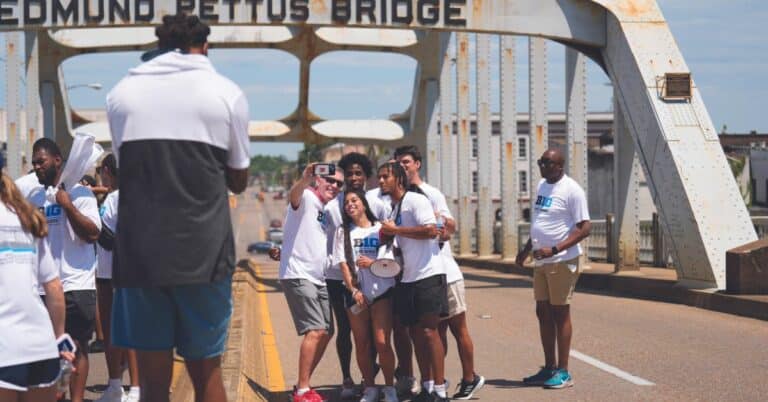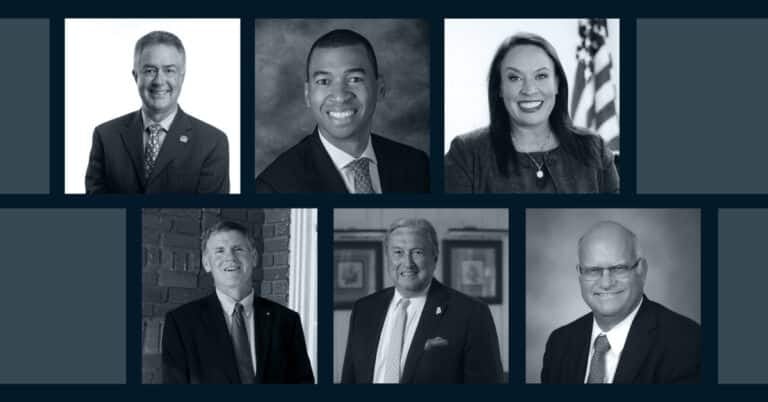Photography by Travis Ellison
Montgomery is leveraging the area’s compelling Civil Rights history to attract group travel, benefitting both the visitors and local businesses.
Montgomery is a hub of significant history, and in recent years, a deeper appreciation for this has drawn tourists from around the globe. More tourism is always good for the area’s economy. But a recent influx of corporate groups looking to harness the stories of the city’s past to bolster their Diversity, Equity and Inclusion (DEI) efforts is also providing business benefits. One obvious plus of group travel is getting more “heads in hotel beds,” and therefore more tax revenue and more people spending money locally.
But, these groups are also underscoring the valuable experiences right here that Central Alabama-owned and -based businesses can use as they seek to enhance DEI in their offices, Experience Montgomery’s Executive Director Ashley Jernigan explained. “In the wake of events in the past five years, there is a need and want to have a better understanding of social justice to enhance diversity and inclusion in schools, in organizations and at work, and here, our Civil Rights history is key to that. You leave with the truth of not only what happened before, but what is happening now too,” Jernigan said. “That’s something these groups are taking advantage of, but also something businesses right here at home can tap into.”
Putting emphasis on DEI in the workplace increases employee morale and can boost your bottom line. Recent studies show how a variety of backgrounds and experiences foster a culture of innovation, while also ensuring every employee feels invested, which translates to increased loyalty and often increased productivity.
Game Plan: DEI
The NCAA’s Big Ten Conference understands how motivating a tour of the area’s historic sites can be; its leadership brought 200 staff and student-athletes, including some from the PAC-12 and the ACC, to Montgomery in July 2022 for its inaugural Big Life Series event. The visit also marked Experience Montgomery’s first curated DEI experience. They got so much out of the field trip, they came back for a second visit this past July; this year, 125 people made the journey south.
The trips grew out of a 2020 Big Ten initiative called The Equality Coalition, which highlighted the importance of voting rights. “We wanted to do a voting rights history trip,” said Omar Brown, Big Ten Conference’s Senior VP, Community & Impact Officer. “Originally, the plan was 14 students going to Selma to cross the Edmund Pettus Bridge, but as we looked into it, we saw how much related rich history there is in Montgomery.” The scope of the trip grew, as did the number of people who wanted to come, which meant Montgomery— with its regional airport, plus plenty of hotels and other tourism infrastructure—better fit the group’s needs.
“I’m so glad we ended up expanding. The bridge crossing was moving, but in Montgomery, we saw the other side of the struggle and the story,” Brown said, “through the Civil Rights Interpretive Center at ASU, plus the Legacy Museum and the Memorial for Peace and Justice. We left thinking Selma is a vital spoke, but Montgomery is the hub.” The group ate at locally owned restaurants—The Cheesecake Empori-Yum was a favorite—stayed and conducted meetings at The Renaissance Hotel and explored the capital city’s walkable downtown.
The Power of Up Close & Personal
“The overall impression was compelling for all of us,” Brown said. “What the students saw and learned showed them they each have the power to make a change in today’s world.” Jernigan echoed Brown, noting the difference that comes from connecting with these sites in person. “We have multiple college-age groups who come do these visits annually, and it’s cool to watch young people viewing the photos of these Civil Rights warriors and figuring out how young many of them were,” she said. “They are often surprised but also excited to see they can impact change too.”
Jordan Robinson, a sophomore on the UCLA track team, called the visit “eye opening.” “It showed me how we [young people] need to look beyond thinking about ourselves,” she said. “We can stand up now. We don’t have to wait for older people to do it. We can be the change we want to see.”
Hamsika Arnipalli, a sophomore on The Ohio State University fencing team, noted the intricate details gleaned from seeing history (not just reading about it) at the Legacy Museum. “As a person who is not part of the Black community, most of what I learned about slavery came from public school,” she said. “Seeing more of the personal aspects was shocking and gut-wrenching. You feel there is still more work to do.”
In 2022, when University of Michigan students were in the ASU Interpretive Center, they noticed photos showing past Wolverine students standing up for civil rights alongside others in Montgomery. “That really drove it home for them,” Brown said.
Individuals are motivated by the spirit stirring details of the 1950s and 1960s fight for inclusion, but these trips can provide team building too. Following the 2022 visit, several of the student-athletes commented on how the shared pursuit strengthened team bonds.
Immersion & Inspiration
During the Big Ten’s 2023 visit, Dr. Lawrence Chatters, Executive Associate Athletic Director for Strategic Initiatives at The University of Nebraska, pointed to the intentionality built into their itinerary as a highlight, as well as the warm welcome. “The hospitality was so nice,” he said. “And the visit exposed these students to the people on the ground in the Civil Rights Movement. It was great to see them find power as they saw such resilience in action; it was all enriching.”
The impression Montgomery’s history made on participants of the Big Ten trips proves its ability to appeal to a wide range of visitors and groups, a fact Jernigan said has been apparent but is now being re-emphasized. “The opportunities our historic sites provide for learning about important U.S. history have been drawing visitors and groups, from family reunions to conferences, for years, but we’re now focusing on marketing Montgomery this way.”
The results are Montgomery Immersion Experiences, which are designed by Jernigan and her team to include tailored itineraries that meet groups’ specific wishes and needs. The Big Ten group is only one example. She pointed to the 150 people—including the mayor, city council and county commissioners—from Alexandria, Virginia, who recently enjoyed an experience curated just for them. “They did a remembrance project that connected their history to ours,” she said. They brought soil from a local lynching site with them and presented it to EJI, while also taking in Montgomery’s and Selma’s civil rights sites.
Jernigan again stressed the impact these visits can have. “Everyone who does them moves through this journey of what happened, but also, where we are headed and what should happen next,” she said, “and everyone leaves feeling empowered and energized.”







